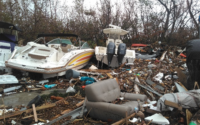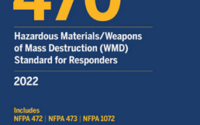What is the Backup Teams duty on an Encapsulating Entry?
Jeff Zientek

What is the Backup Teams duty on an Encapsulating Entry?
This question comes up often when discussing a Level A (or an encapsulating Level B) entry. There is the concept of the Backup Teams duty is to finish the job in case the Entry Team cannot, but also in place for a rescue should the Entry Team have an issue. Then there is the other concept that the Backup Teams duty is simply to be dressed equal to Entry, on air, and in close proximity (eyes on Entry preferably) to rescue any member (Entry or Backup) in case they have an issue. There are arguments for each case that are valid and this article is meant to allow teams to discuss and develop a clear definition of what the main purpose is for their Backup Team, stick to it and train on it, but also remember that member safety should always be the main concern!
After reading that last statement, you have probably guessed my stance on the topic.
The system I grew up in, in my hazmat tenure, we dressed our Backup Team the same as the Entry Team and when everybody was ready, they all went downrange on air. The Backup Team had their pre-designated staging area (eyes on Entry but not in the product), and the Entry continued on to the work area. This provided MAXIMUM member safety in case something was to happen to the Entry Team. Let’s face it, Level A or Level B encapsulating chemical protective clothing (CPC) is the worst type of PPE a member can operate in. We often think that there is little chance that something will happen (reaction-wise, splash, exposure etc.) while working around the product in the CPC, however we forget the possibility of a person having a medical emergency inside these suits (most likely). The rescue of a member down, inside an encapsulating suit, in a chemical environment, with nothing to grab on their suit to assist in rescuing, transporting them out of the hot zone to safety, is a difficult task in itself, plus than having to get them out of their encapsulating suit to provide medical attention. That is a ton of work to accomplish! Add in to that if the Backup Team is staged half or three-quartered dressed in the cold zone, they have to quickly go on air, get zipped up properly, and make their way to the work area in the hot zone and hopefully there are no obstacles such as key, card, or coded locked doors, stairs up or down to negotiate, and then locate the stricken member(s). All these factors came into the reasoning for our system to have the Backup Team located in close proximity to where the Entry Team is working. Yes, there is the argument that the Backup Team is using air that they may need to perform a rescue. In all of the studies we conducted the Backup Team had more air leftover than the Entry….for obvious reasons. And the Backup Team only needs to get them out of the hot zone and to a safe area where another team (the Rescue team) can perform a quick decon and the suit cut out, then hand off to medical (which will be discussed in a later article). There also is the argument that there are not enough members to fulfill this concept. In other words, if the Entry Team does not accomplish the task, there is another team ready to go in and continue the work, as opposed to burning 4-8 members per entry. This is a valid point, however, if your team is this small, this may be a case to bolster the number of members for your team……an increase to address member safety! I know that may be a pipe-dream but teams should always strive to increase their teams’ members, knowledge, equipment, capabilities, and of course…..safety!

So, what does OSHA and NFPA say about the hazmat Backup Team? OSHA’s description states: “Back-up personnel shall stand by with equipment ready to provide assistance or rescue. Advance first aid support personnel, as a minimum, shall also stand by with medical equipment and transportation capability” (1910.120(q)(3)(vi). This description, in my opinion, allows for some wiggle room for not sending your Backup Team to monitor the Entry Team. However, it seems to lean more towards rescue being at the top priority instead of “assistance” (however a team would define that general term).
As for NFPA, until recently (Jan. 2017) they agreed that they did not have an actual definition or function statement for Backup Team (that is not paraphrased but the exact wording of meeting notes). Some may argue that having general descriptions for hazmat operations allow for more flexibility at incidents, while others may say it’s better to have a clearer, more defined way to operate. A clearer definition allows teams to train consistently, operate consistently, and if they are unable to do that, they need to adjust their program to fall into the standard. The definition for Backup Team in NFPA 470 states, “A required team compromising two or more responders equipped with approved personal protective equipment (PPE) chemical protective clothing (CPC) and assigned by the Incident Commander to provide emergency removal of a stricken member of the entry team in the hot zone” (3.3.7). Now, to be fair, there is a section in A3.3.7 which states: “The backup Team could be used to assist the entry team if help is needed assisting with equipment requests or more hands on task like working on top of a rail car. If a backup team goes in to assist the entry team, another backup team is put in place. If the entry team mission cannot be completed by the initial entry team the backup team can become the next entry team after a briefing where mission tasks are identified, and another backup team is in place”. There is a lot to digest there, I believe either side could state their case, depending on what statements you plan to use and what is a priority to the team (OUCH!). There is more wording surrounding the three sentences I took out of A3.3.7 and if a team struggles with the Backup Team concept, I would encourage the team to read everything relating to Backup Team in the newly revised NFPA 470 and discuss with the team the way they intend to operate.
If your team’s procedure is staging the Backup Team in the dressing area half or three-quarter dressed, keep this in mind. Don Abbott’s Project Mayday came up with this statistic and conclusion after gathering data from real hazardous materials incidents Maydays; “All back-up teams involved in these operations were not completely ready for rescue (equipment lacking), average time getting zipped up and on air in dressing and entry into hot zone (this is just the hot zone and not stricken member contact), 6:23 and Backup Team still required additional assistance to remove stricken member”. Having the Backup Team dressed equally and on air, within close proximity to the Entry Team, greatly reduces the time to reach the stricken member and remove to safety, which in turn gets the member treated quicker and increases survivability! Here is something interesting to compare this to. NFPA 1710 established 5 minutes as the goal for response times for 90% of emergency incidents…..this for the people we serve. If we are already at the scene of a hazmat incident, shouldn’t we do at least as good……but hopefully better, than what we do for our public?
Try this with your team; practice and drill on removing stricken members from the hot zone. And not just getting them out of the hot zone but getting them deconned, cut out of their encapsulated suit, on to medical, AND the remaining Entry and Backup members being deconned during this process. Note the efficiency and/or inefficiency of all aspects of the process, because a failure in one portion can have drastic effects on another part of the process. And of course, the more we train on it, the better we get and it can become automatic.



